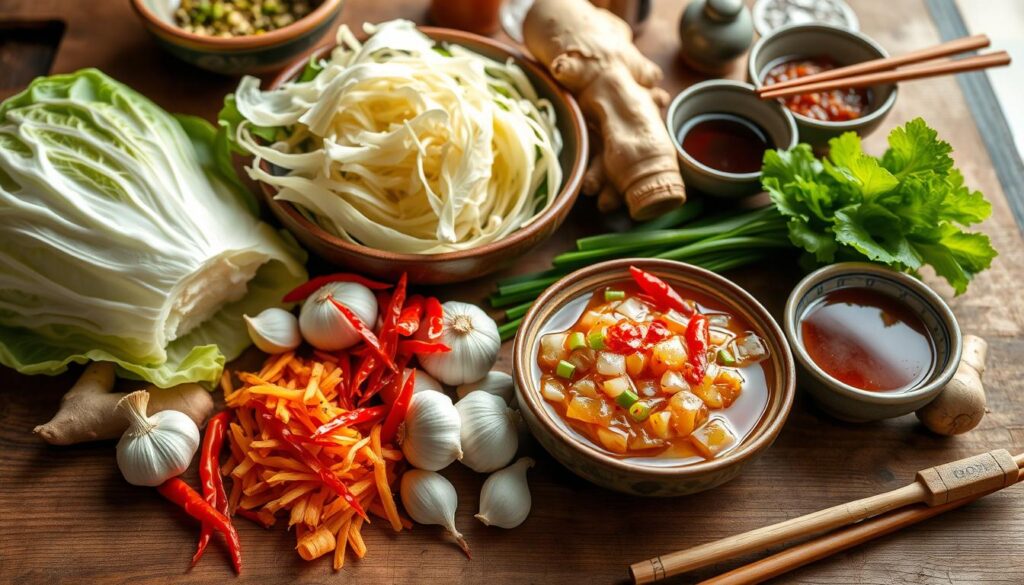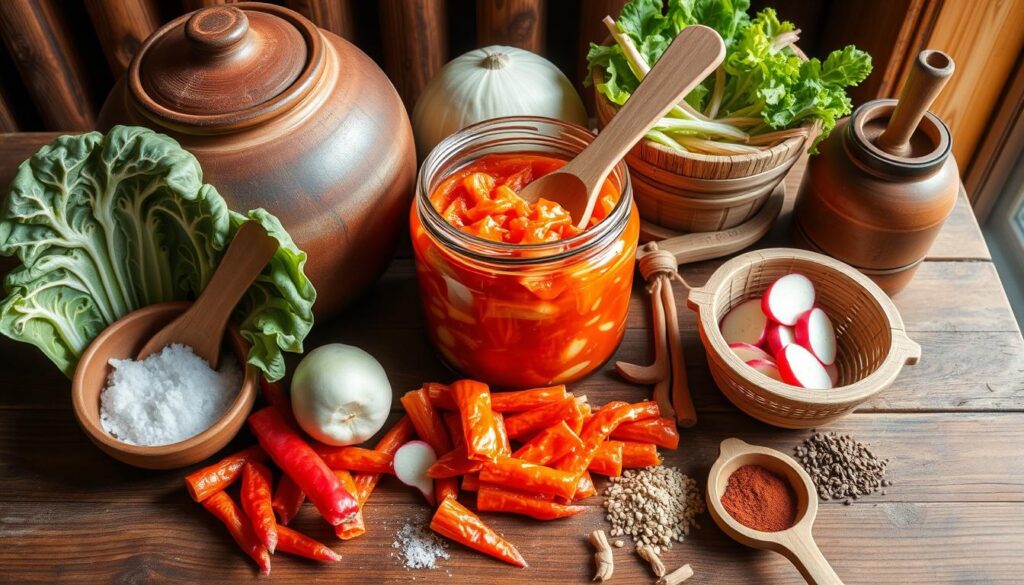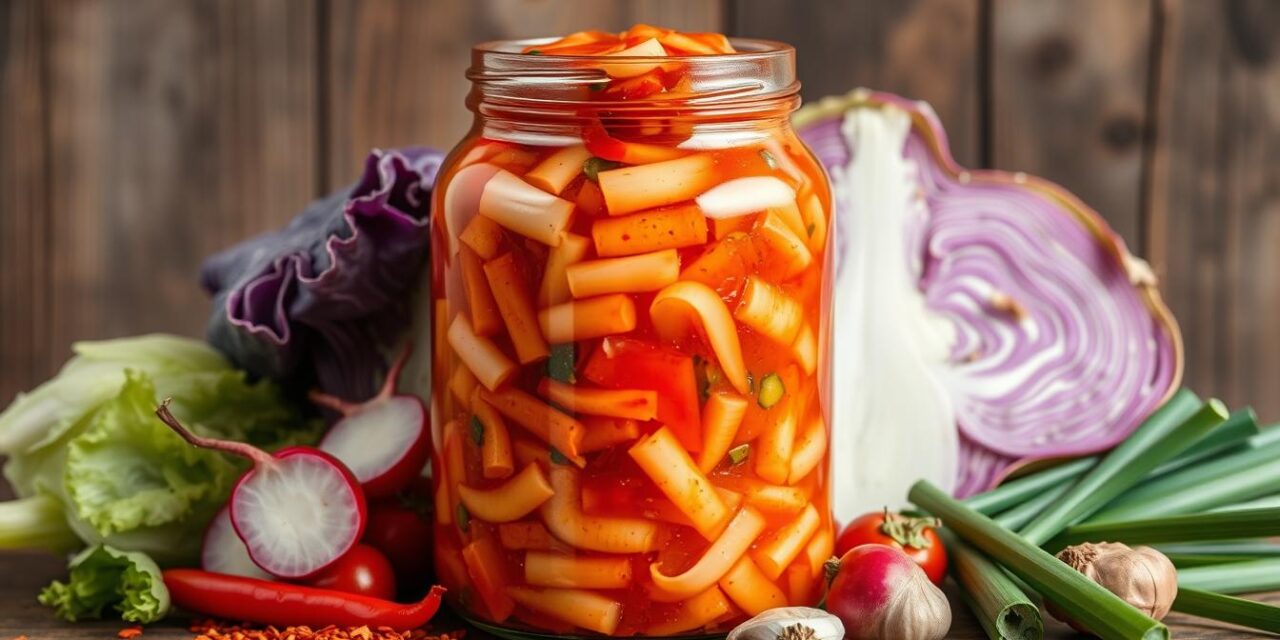Did you know Australians eat about 2.2 kilograms of kimchi each year? This Korean fermented cabbage dish is loved worldwide. It’s full of probiotics, great for your gut and health. Now, you can make your own kimchi at home, just how you like it.
Say goodbye to store-bought kimchi. Start enjoying homemade, gut-friendly kimchi. It will make your taste buds happy.
Key Takeaways
- Kimchi is a probiotic-rich fermented cabbage dish with numerous gut health benefits.
- Making kimchi at home is simple and allows you to customise the flavours.
- Homemade kimchi can support your digestive system and overall wellbeing.
- Discover the history and cultural significance of this traditional Korean food.
- Learn the essential ingredients and step-by-step guide for preparing authentic kimchi.
Understanding Traditional Korean Kimchi and Its Origins
Korean cuisine is rich and full of history, with kimchi at its heart. This fermented vegetable dish has been a big part of Korean culture for ages. The way kimchi is made has changed over time, showing how clever and adaptable Korean cooks have been.
Historical Significance in Korean Cuisine
Kimchi has been a key part of Korean families for many generations. It first appeared in the 3rd century AD. Back then, it was just salted and fermented veggies, eaten with main meals.
But over time, kimchi recipes got more complex. They started using different ingredients and flavours. These changes have made kimchi a big part of Korean food culture.
Evolution of Kimchi Making Techniques
- At first, kimchi was made with local veggies like napa cabbage and radish. Salt and natural bacteria were used for fermentation.
- With more trade and cultural exchange, new things like chili peppers and garlic were added. This made kimchi taste richer and more complex.
- Today, new ways of preserving and fermenting have improved kimchi making. This means kimchi lasts longer and tastes better.
Cultural Impact and Global Popularity
Kimchi is more than a side dish in Korea. It’s a symbol of the country’s history, food traditions, and community values. Making and sharing kimchi is a family affair that brings people together.
In recent years, Korean food has become popular worldwide. Kimchi is now enjoyed globally, including in Australia. It’s seen as a healthy and tasty addition to meals.
| Traditional Kimchi Making | Modern Kimchi Making |
|---|---|
| Use of local, seasonal vegetables | Wider variety of ingredients |
| Reliance on natural fermentation | Advancements in food preservation |
| Communal, family-centered process | Increased commercial production |
“Kimchi is more than just a dish; it is a reflection of Korean identity, history, and community.”
Essential Ingredients for Authentic Kimchi Preparation
Making a traditional fermented cabbage dish like Korean kimchi needs careful picking of ingredients. The main ingredient is cabbage, which is at the heart of this Korean cuisine classic. Napa cabbage and Savoy cabbage are the most used, adding their own textures and tastes.
Spices and seasonings mix to give kimchi its unique flavour. Gochugaru, a Korean red chilli pepper, adds the fiery kick. Garlic, ginger, salted shrimp or fish sauce, and Korean radish are also key.
- Napa cabbage or Savoy cabbage
- Gochugaru (Korean red chilli pepper)
- Garlic
- Ginger
- Salted shrimp or fish sauce
- Korean radish
While these ingredients are crucial for traditional Korean kimchi, recipes can be tweaked. In Australia, daikon can replace Korean radish, and different veggies can be used.
“The beauty of kimchi lies in its ability to embrace a diversity of flavours while remaining true to its cultural heritage.”
By choosing and mixing these key ingredients, home cooks can make a real and tasty fermented cabbage dish. It captures the true spirit of Korean cuisine.

Health Benefits and Probiotic Properties of Fermented Cabbage
Eating fermented cabbage, like kimchi, is good for your health. The fermentation process makes it full of probiotics. These probiotics help your gut, boost your immune system, and fight inflammation.
Gut Microbiome Enhancement
Fermented foods, like kimchi, are full of good bacteria. These probiotics help keep your gut microbiome healthy. They aid digestion, improve nutrient absorption, and keep your gut flora balanced. This is key for your gut health benefits.
Immune System Support
Eating kimchi can boost your immune system. The probiotics in kimchi help make more natural killer cells. This strengthens your body’s defence against sickness and infection.
Anti-inflammatory Effects
- The active cultures in fermented cabbage have anti-inflammatory properties. They help reduce body inflammation.
- Kimchi is also full of antioxidants and vitamins. These help fight inflammation and improve your overall health.
Recent studies have shown the many health benefits of eating fermented cabbage. Adding this probiotic-rich food to your diet is easy and tasty. It supports your gut microbiome, immune system, and overall well-being.

Required Kitchen Tools and Equipment
For traditional kimchi making, the right tools are key. They help with perfect fermentation and flavour. Whether you’re new or experienced, the right utensils are crucial for your homemade kimchi.
To start your kimchi making journey, you’ll need a few things:
- A large, non-reactive bowl or container, like glass or food-grade plastic, for mixing and fermenting.
- A sturdy wooden or plastic spatula for mixing and packing the kimchi.
- A set of measuring cups and spoons for accurate ingredient amounts.
- A sharp knife and cutting board for chopping vegetables.
- A fine-mesh strainer or colander for rinsing and draining the cabbage.
- An airlock system or fermentation weights to keep the kimchi submerged.
- Airtight containers or jars for storing the fermented kimchi.
While Korean kimchi making uses special tools, you can use common kitchen items in Australia. Make sure your tools are food-safe, clean, and fit the task.
With the right equipment, you can make authentic and tasty traditional kimchi at home.
| Traditional Korean Kimchi Tools | Modern Australian Alternatives |
|---|---|
| Makgeolli jar | Wide-mouth glass or food-grade plastic container |
| Jeotgal jar | Airtight fermentation crock or jar with airlock system |
| Wooden kimchi stirring paddle | Wooden or plastic spatula |
| Kimchi pressing plate | Fermentation weights or plate with a heavy object |

“The right tools make all the difference when crafting the perfect traditional kimchi.”
Kimchi Recipe for Gut: Step-by-Step Preparation Guide
Are you ready to make kimchi? This guide will show you how to make a fermented cabbage dish that’s good for your gut. You can do it all in your Australian kitchen. Let’s start and learn how to make kimchi that tastes great and is good for your health.
Cabbage Selection and Preparation
Choosing the right cabbage is key to making great kimchi. Look for fresh, crisp Napa or Korean cabbages. They have a soft texture and strong flavour. Clean and cut the cabbage into small pieces for even fermentation.
Creating the Perfect Spice Paste
- Get your spices ready. You’ll need Korean red pepper flakes, minced garlic, grated ginger, and fish sauce or salted shrimp paste.
- Mix these ingredients in a bowl to make a fragrant spice paste.
- Spread the spice paste all over the cabbage. Make sure every part is covered for the best flavour and colour.
Fermentation Process
The last step is fermentation. Put the cabbage with spice paste in a clean, airtight container. Press it down to get rid of air pockets. Cover it and let it ferment at room temperature for 3-7 days. This will make it tangy and textured.
Check the kimchi often and press it down to release gases. When it’s done, put it in the fridge. It will last for months.

Follow these steps to make homemade kimchi. It’s delicious and good for your gut. Enjoy it as a side dish, a topping, or a probiotic-rich snack. It will be a favourite in your Australian kitchen.
Storage Tips and Fermentation Timeline
To get the most out of your homemade probiotic-rich food kimchi, you need to store it right. Knowing how fermentation works is also key. Here’s a simple guide to making your kimchi perfect every time.
Ideal Fermentation Conditions
For great kimchi, keep it cool and dark. The best temperature is between 15-22°C. This helps the good bacteria grow, making your cabbage tangy and full of probiotics.
Fermentation Timeline
The time it takes for kimchi to ferment depends on what you like. Here’s a basic guide:
- 3-5 days: It tastes mild and a bit tangy.
- 7-10 days: It gets more complex and balanced.
- 2-4 weeks: It’s very fermented, with a strong taste.
Just taste it to see if it’s ready. When it’s tangy enough for you, it’s time to chill it and enjoy your probiotic-rich food.
Proper Storage
Keeping your kimchi in the right place is crucial. Put it in an airtight container and keep it cold. This slows down fermentation and keeps the probiotics good for months.
“The longer kimchi ferments, the more complex and robust its flavour becomes – but be sure to refrigerate it when it reaches your preferred taste.”
| Fermentation Stage | Flavour Profile | Probiotic Potency |
|---|---|---|
| 3-5 days | Mild, slightly tangy | Moderate |
| 7-10 days | Complex, well-rounded | High |
| 2-4 weeks | Bold, pungent | Very High |
Common Mistakes to Avoid When Making Kimchi
Making kimchi at home can be rewarding, but watch out for common mistakes. I’m here to share tips to help you avoid these issues and get great results.
Temperature Control Issues
Keeping the right temperature is key for good kimchi. If the temperature changes, your kimchi might not turn out right. Try to keep it between 18-22°C (64-72°F) and watch out for temperature changes in your area.
Salt Balance Problems
Getting the salt just right is important. Too little salt makes it too sour, and too much makes it too salty. Make sure to measure the salt well and mix it evenly for the best taste.
Fermentation Troubleshooting
- Uneven fermentation: Pack the kimchi tightly and evenly to help it ferment well.
- Lack of bubbles: If you don’t see bubbles, your fermentation might be slow. Try changing the temperature or adding a starter culture.
- Mould growth: Mould can grow if the container isn’t sealed well. Always use an airtight container and check on your kimchi often.
By avoiding these common mistakes, you can make great kimchi. Enjoy the health benefits and delicious taste of this traditional dish.
Vegetarian and Dietary Variations
In Australia’s diverse food scene, it’s key to cater to different diets. The vegetarian-friendly recipe of kimchi has been adapted in creative ways. This is to meet the needs of various lifestyles and diets.
Vegetarians and vegans can replace animal products with plant-based ones. Fish sauce, a key ingredient in traditional kimchi, can be swapped with soy sauce, tamari, or a mix of miso paste and water. This keeps the dish’s umami flavor intact.
- Soy Sauce: A versatile substitute that provides a savory, umami-packed punch to the kimchi.
- Tamari: A gluten-free soy sauce alternative, offering a deeper, richer flavor profile.
- Miso Paste and Water: A plant-based blend that captures the essence of fish sauce’s briny essence.
Creative cooks have come up with many vegetarian-friendly recipe variations. They use a variety of vegetables, herbs, and spices. This creates unique flavors. From colorful kimchi to mushroom-based versions, there’s a lot to try.
Whether you’re a vegetarian, health-conscious, or just looking to try new foods, kimchi is a great choice. It’s a nutritious and tasty way to explore different flavors. It’s also a great way to meet your dietary needs.
Incorporating Kimchi into Daily Meals
Kimchi, the iconic Korean fermented cabbage dish, is more than just a condiment. It can make your everyday meals in Australia more exciting. From breakfast to dinner, it brings a unique twist and health benefits to your dishes.
Breakfast Options
Begin your day with a nutritious kick by adding kimchi to your breakfast. Mix it into scrambled eggs for a tasty and probiotic-rich start. Or, top your avocado toast with tangy kimchi for a quick, easy option.
Main Course Suggestions
Kimchi’s versatility is clear in main dishes too. Stir-fry it with veggies and your favourite protein for a Korean-inspired stir-fry. It’s also great in soups, stews, and as a topping for grilled meats or fish.
Creative Fusion Recipes
Get creative by mixing Korean kimchi with Australian dishes. Try a kimchi-infused pizza or kimchi fried rice for a unique taste. Kimchi is also a low-calorie way to add flavour to weight loss meals.
Adding kimchi to your meals is a simple way to enjoy Korean cuisine’s rich flavours. It also offers probiotic benefits and can help with weight loss. Experiment with different ways to use this versatile ingredient in your cooking.
Conclusion
We’ve explored the history, cultural importance, and health perks of homemade kimchi. This fermented cabbage dish has become a global favourite. It’s known for boosting gut health and wellbeing.
Now, Australians can make their own kimchi at home. We’ve given you a step-by-step guide. This will help you make a delicious, authentic kimchi.
Adding kimchi to your meals can do wonders for your health. It’s full of good bacteria that helps your gut and immune system. Enjoy it as a side, in recipes, or as a snack. Making your own kimchi recipe for gut is a great way to improve your gut health benefits and health overall.






